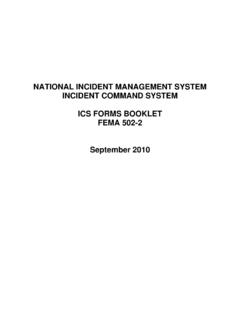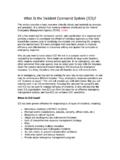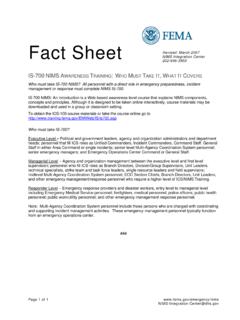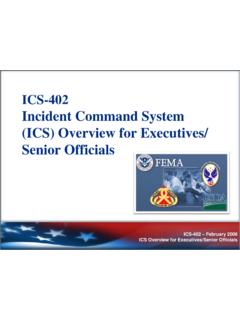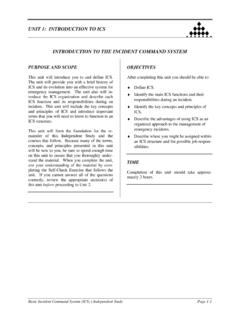Transcription of by K.M. Cohen, S.C. Finney, P.L. Gibbard, and J.-X. …
1 Episodes Vol. 36, no. 3199by Cohen1, Finney2, Gibbard3, and Fan4 The ICS international chronostratigraphic Chart1 Faculty of Geosciences, Utrecht University, Utrecht, The Netherlands. E-mail: of Geological Sciences, California State University, Long Beach CA, USA. E-mail: Quaternary, University of Cambridge, Cambridge, England, UK. E-mail: Key Laboratory of Palaeobiology & Stratigraphy, Nanjing Institute of Geology & Palaeontology, CAS, Nanjing, PR uses the units and formally defined boundaries as internationalstandards: they are included in the library of GeoSciML, an applicationfor globally accessing standards-based geoscience data andinformation.
2 Furthermore, the GSSPs (Global Boundary StratotypeSection and Point) that define the boundaries are recognized asinternational geostandards, at which ICS encourages the placementof markers, educational exhibits, and even golden spikes in well-attended dedication ceremonies (Schmitz et al., 2011: their Fig. 4;Morton, 2012). Here we present the most recently updated versionof the ICS chart dated January 2013 (Fig. 1).From earlier editions, we have continued the organisation of thechart in four columns. Three columns present the Phanerozoic,showing four systems in each column. At the lowest level they display34 + 34 + 32 stages.
3 The stage names are derived from stratotypeareas, and the stages are defined primarily on marine faces. The fourthcolumn shows the Precambrian, sub-divided to system level. Aninnovation to the layout is that the stages of greater temporal durationare shown with thicker intervals in the columns. The numerical agesmake clear that the chronostratigraphic units are not of equal temporalduration and that the geological time scale is not a linear one. Thethree Phanerozoic columns span 145, 214 and 182 Ma respectively,but have equal heights in the chart . Within these columns, each stageis given a fixed proportion of the column height ( , 2%).
4 Theremaining height (100 (34 x 2) = 32% in the example) is thendistributed proportionally to the stages that cover more than the fixedproportion on a linear timescale for that column. With the design wehave tried to communicate visually, in improved style, that the divisionof Phanerozoic geological time is irregular and governed by thestratigraphical successions on which the units were originally defined,to which many subsequent revisions have been made. The chart designis intended to be advantageous in the daily use for both professionalgeologists and other users divisions and Golden Spikes Units of all ranks are in the process of being defined by GSSP sfor their lower boundaries, including those of the Archean andProterozoic, the latter long defined by Global Standard StratigraphicAges (GSSA).
5 The status of each GSSP is displayed in the chart bysmall golden-spike icons at the base of the divisions that they status of each GSSA is indicated similarly with clock boundaries in the Phanerozoic for which no GSSP is currentlyratified, or which lack constraining numerical ages, an approximatenumerical age (~) is provided. Note that numerical ages do not defineunits in the Phanerozoic and the Ediacaran, they are only defined international Commission on Stratigraphy (ICS)has a long tradition of producing international chartsthat communicate higher-order divisions of geologicaltime and actual knowledge on the absolute numericalages of their boundaries.
6 The primary objective of ICSis to define precisely a global standard set of time-correlative units (Systems, Series, and Stages) forstratigraphic successions worldwide. These units are, inturn, the basis for the Periods, Epochs and Ages of theGeological Time Scale. Setting an international globalstandard is fundamental for expressing geologicalknowledge. It is also of considerable pragmaticimportance as it provides the framework through whichregional-scale higher-resolution divisions can be linked,equated and collated. This is a status update on theInternational chronostratigraphic chart and the ICSwebsite the 34th international Geological Congress, in 2012 in Brisbane,over 6000 delegates found the redesigned InternationalChronostratigraphic chart of the international Commission onStratigraphy (ICS) in their conference packages.
7 The ICS chart is ahierarchy of chronostratigraphic units ( Systems, Series, andStages) on which geochronological units ( Periods, Epochs, andAges) are based. With the addition of calibrated numerical ages forunit boundaries it serves as the international Geological ICS chart caters to a range of users: geologists that are relativelynew to a particular time-stratigraphic interval and seek to place nameddivisions in their correct order and hierarchical structure, professionalswho need to look up the latest specific estimates of numerical ages,earth science students at all levels, and the general public interestedin the long history of the Earth.
8 For the international Commission onStratigraphy, the chart is also important for communicating theprogress in formalising a single set of global chronostratigraphic unitsdefined by specific boundaries, and for communicating standards ofcolour coding the divisions for use on geological maps and sections,using the scheme established by the Commission for the GeologicalMap of the World (CGMW: ). Furthermore, theCommission on the Management and Application of GeoscienceInformation (CGI) of the international Union of Geological SciencesPhanerozoicCenozoicQuaternaryHol ocenePleistocenePlioceneMioceneOligocene EocenePaleoceneNeogenePaleogeneUpperLowe rCretaceousMesozoicTriassicCarboniferous MesozoicPermianJurassicUpperLowerMiddleU pperLowerMiddleLopingianGuadalupianCisur alianUpperLowerUpperMiddleMiddleLowerMis sissippianPennsylvanianPaleozoicMiddleUp perCalabrianGelasianPiacenzianZancleanMe ssinianTortonianSerravallianLanghianBurd igalianAquitanianChattianRupelianPriabon ianBartonianLutetianYpresianThanetianSel andianDanianMaastrichtianCampanianSanton ianConiacianTuronianCenomanianAlbianApti anBarremianHauterivianValanginianBerrias ianTithonianKimmeridgianOxfordianCallovi anBathonianBajocianAalenianToarcianPlien sbachianSinemurianHettangianRhaetianNori anCarnianLadinianAnisianOlenekianInduanC hanghsingianWuchiapingianCapitanianWordi anRoadianKungurianArtinskianSakmarianGzh elianFamennianFrasnianGivetianEifelianEm sianPragianLochkovianLudfordianGorstianH omerianSheinwoodianTelychianAeronianRhud danianHirnantianKatianSandbianDarriwilia nDapingianFloianTremadocianStage 10 JiangshanianPaibianGuzhangianDrumianStag e 5 Stage 4 Stage 3 Stage 2 FortunianKasimovianMoscovianBashkirianSe rpukhovianViseanTournaisianTerreneuvianS eries 2 Series ~ ~ ~ ~ ~ ~ ~ ~ ~ ~ 237~ ~ ~ 494~ 497~ ~ ~ 509~ 514~ 521~ 529~ ~ 6358501000120014001600180020502300250028 00320036004000~ 4600presentSeries / EpochStage / Agenumericalage (Ma)Eonothem / EonErathem / EraSystem / PeriodSeries / EpochStage / Agenumericalage (Ma)Eonothem / EonErathem / EraSystem / PeriodSeries / EpochStage / Agenumericalage (Ma)System / PeriodErathem / Eranumericalage (Ma)Eonothem / EonErathem / EraSystem / PeriodEonothem / EonGSSPGSSPGSSPGSSPGSSAINTERNATIONAL chronostratigraphic CHARTI nternational Commission on follows the Commission for the Geological Map of the World.
9 Drafted by Cohen, S. Finney, Gibbard(c) international Commission on Stratigraphy, January 2013 of all ranks are in the process of being defined by Global Boundary Stratotype Section and Points (GSSP) for their lower boundaries, including those of the Archean and Proterozoic, long defined by Global Standard Stratigraphic Ages (GSSA). Charts and detailed information on ratified GSSPs are available at the website The URL to this chart is found below. Numerical ages are subject to revision and do not define units in the Phanerozoic and the Ediacaran; only GSSPs do. For boundaries in the Phanerozoic without ratified GSSPs or without constrained numerical ages, an approximate numerical age (~) is ages for all systems except Permian,Triassic, Cretaceous and Precambrian are taken from A Geologic Time Scale 2012 by Gradstein et al.
10 (2012); those for the Permian, Triassic and Cretaceous were provided by the relevant ICS 2013/01 Cohen, , Finney, , Gibbard, and Fan, , 2013, The ICS international chronostratigraphic chart , Episodes, v. 36, no. 3, pp. follows the Commission for theGeological Map of the World. drafted by Cohen, Finney, Gibbard international Commission on Stratigraphy, January 2013 2013202 Most of the systems, series and stages were first defined fromtype-sections in Europe, the historical home of study of stratigraphical successions worldwide has ledto a proliferation of regional units. These historical units did allowPhanerozoic strata to be correlated and mapped worldwide.











